Like RnB, beat making, specifically hip hop, was born out of poor communities. The urban ghettos were the hub of hip hop in its infancy. With little or no money to buy instruments, young people looked at other ways to make music. And so, in the 1970s, the turntable became the new instrument creating scratches, loops, breaks and beats. DJs, like Afrika Bambaataa and Grandmaster Flash in the Bronx, NY, exploited its uses frequently.
In 1979, the first digital sampler and drum machine was produced by Roger Linn, the Linn LM-1. The following year, the Roland TR-808 drum machine would become one of the most popular electronic instruments ever made, helping to produce more hit records than any other. Although it lacked the sophistication of the Linn LM-1, it was about a quarter of the price, and therefore, attractive to young hip hop artists producing their own music. It also had a certain crudeness and rawness to its beats and kicks that appealed. And it had a great impact on the emergence of new genres like “electro-funk”, considered to be fathered by Afrika Bambaataa. The 808 was only manufactured for three years, but second hand 808s would be used in some of the most iconic hip hop music, such as the Beastie Boys’ album License to Ill. They combined samples of rock classics with the 808 beats.
The technology advanced swiftly in the 1980s with the release of the E-mu SP-12, and soon after, the SP-1200 which now, for the first time, had the ability to build a song using just one portable device. The MPC60 came out in 1988, a collaboration between manufacturer Akai and producer Roger Linn. MIDI sequencing and audio sampling were now combined with a set of velocity/aftertouch-sensitive performance pads. Complex and eclectic mixes of samples from several genres were being recorded by producers such as Dr. Dre, Prince Paul and the Dust Brothers.
In the 1990s, the Akai company continued to build on their early gear with machines that combined a sampling drum machine with an onboard MIDI sequencer. A new style was brought to the forefront with the 1994 release of The Notorious B.I.G.’s Ready to Die where producer Sean Combs and his assisting producers sampled entire sections of records instead of short bits of songs. In the 2000s, this type of sampling began to peak with producers Kanye West and Just Blaze sampling soul records for Jay-Z’s album The Blueprint. However, in September 2004, a U.S. Court of Appeals in Nashville set a new precedent with musical copyright infringement by ruling that a license is needed in every case of sampling. After the ruling, a shift towards live instrumentation began.


